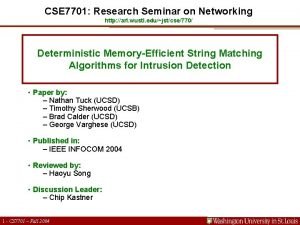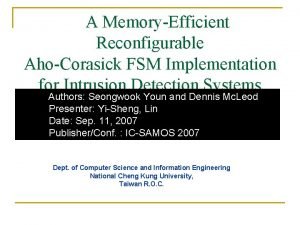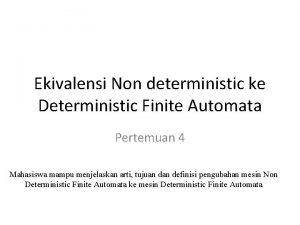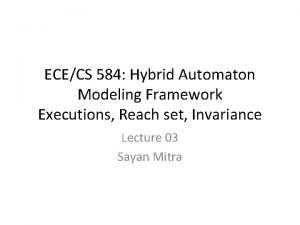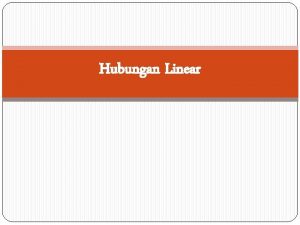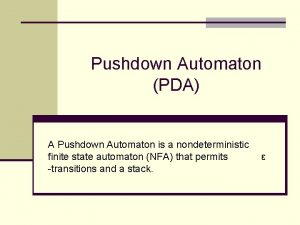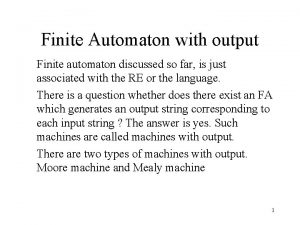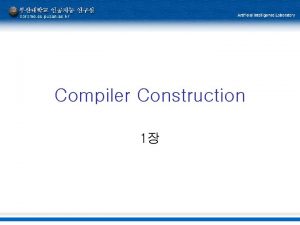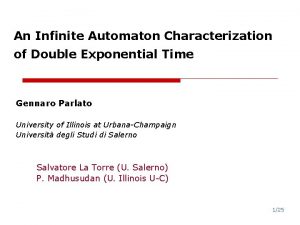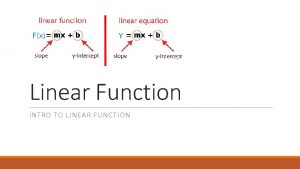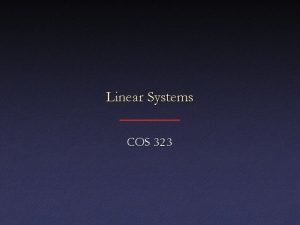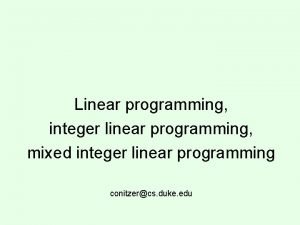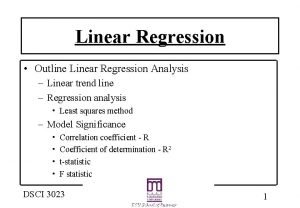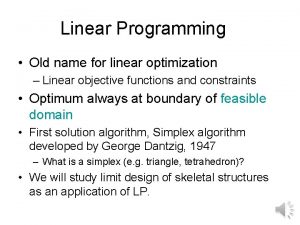Construction of Aho Corasick automaton in Linear time

































- Slides: 33

Construction of Aho Corasick automaton in Linear time for Integer Alphabets Shiri Dori & Gad M. Landau University of Haifa

Overview n Classic Aho Corasick n Our algorithm – Goto Function – Failure Function – Combining the two n Queries in O(m log|Σ|)

Set Pattern Matching Problem n Find patterns in text n P={P 1, P 2, . . . Pq}, in T n Aho and Corasick solved it in ’ 75 n Generalized version of KMP n Uses a state machine

Aho Corasick - Example P = {her, iris, he, is} h i he her ir iris is

Aho Corasick - Example P = {her, iris, he, is} h i he her ir iris Travel along the Goto function, which is a trie of all patterns is If stuck, travel along KMP-style Failure link

Aho Corasick - Example P = {her, iris, he, is} h When found a pattern, output it i he her ir iris Travel along the Goto function, which is a trie of all patterns is If stuck, travel along KMP-style Failure link

Aho Corasick Definitions n Goto function: a trie of the patterns n Failure function: for each label, the largest suffix which is a prefix of a pattern – KMP, but prefix of any pattern qualifies n Output function: patterns ending at this label

Classic Aho Corasick – Analysis n Constructed in O(n) (cumulative pattern length) n Answered queries in O(m + k) n. . . For constant alphabets only! n For integer alphabets, Σ=O(nc), algorithm changes depending on branching method – List, Array or Search Tree n Recent developments inspire for better! – Farach-97; Karkkäinen & Sanders-03; – Ko & Aluru-03; Kim, Sim, Park & Park-03

Our Results n Our algorithm achieves better results: n Construction in O(n) time, O(n) space n Query in O(m log|Σ|) n Works for integer alphabets, Σ = O(nc)

Algorithm: Goto Function n Sort patterns in time linear to their length – By building suffix array of Sp=$P 1$P 2$. . . $Pq$, and just ignoring non-pattern suffixes – Or by two-pass radix sort, O(D + Σ) = O(n) § Paige & Tarjan, ’ 87; Andersson & Nilsson, ‘ 94 n Now create the trie in lexicographic order n Hold a list of sons; insert each new node to the end of the list

Example – Goto Function P = {the, than, this, then} Sorting Patterns P’ = {than, then, this}

Example – Goto Function P’ = {than, then, this} than, the then, then this t th tha the thi than then this

Example – Goto Function P’ = {than, then, this} th t a e i th tha the thi than then this Sorted List, keep the tail

Algorithm: Failure Function n We need to construct Failure links on trie n Original algorithm included traversing trie n We found a deep connection between: – Failure function of the patterns, and – Suffix Tree of the reversed patterns § Or Enhanced Suffix Array § Abouelhoda, Kurtz & Ohlebusch-04; Kim, Jeon & Park-04 n We’ll “learn by example”. . .

Example – Failure Function P = {he, her, iris, is} PR = {eh, reh, siri, si} Failure function: “iris” “is” n The reverses: “siri”, “si” n “si” is a prefix of “siri” n n h i he her ir iris (with $ so “is” prefix of a pattern) is eh (he) h (h) $ $ $ i (i) r (r) si (is) $ $ iri (iri) reh (her) ri (ir) siri (iris) $ $

Understanding Failure Function n Failure function is defined as: largest suffix, which is a prefix of any pattern n Reverse: “largest suffix” “largest prefix” – Any prefix of a label will be its ancestor in ST – Largest means nearest n “prefix of pattern” “suffix of pattern” – It will be a node in the ST, marked by a $ n So: closest ancestor which is marked by $

Algorithm: Failure Function n We found a deep connection between: – Failure function of the patterns, and – Suffix Tree of the reversed patterns n We define Sp=$P 1$P 2$. . . $Pq$ n We define TR to be the suffix tree of (Sp)R n TR can be built in linear time – Can use Enhanced Suffix Array, ER, instead – Note: TR is a Generalized Suffix Tree n How will we link the trie and TR?

Example – 1 -to-1 Mapping Note: “r” doesn’t get a link since it’s not marked by a $ h i he her ir iris is eh (he) h (h) $ $ $ i (i) r (r) si (is) $ $ iri (iri) reh (her) ri (ir) siri (iris) $ $

Example – 1 -to-1 Mapping h i he her ir iris is eh (he) h (h) $ $ $ i (i) r (r) si (is) $ $ iri (iri) reh (her) ri (ir) siri (iris) $ $

Algorithm: Review n Build Goto function (trie) – Sort patterns – Construct trie n Build Failure function – Construct TR – Compute proper ancestor for $-marked nodes n Combine information – Through mapping, create Failure links on trie

Adjustment for Integer Alphabet n We used recent developments (SA, ST) n Constructed Goto: using suffix array n Found a connection between Failure function and suffix trees n Thus, reduced the construction to O(n) n Yet, manage to keep queries at O(m log|Σ|) n Again - how?

Queries in O(m log|Σ|) n We’ve built the trie in O(n) – But we have a sorted list – Search is compromised n Our simple solution…

Example – Goto Function P’ = {than, then, this} th t a th than then e i a e i this Array can be searched in log(#children)

Queries in O(m log|Σ|) n Once the trie is complete – Convert lists in each node to arrays – Array’s size is known; O(n) space overall – Binary search can now be employed n Reduce the time spent in each node to log(# children) = O(log|Σ|) n Can be applied to Suffix Tree built from Suffix Array + LCP

The End Thanks!

Algorithm: Combining the two n Build a 1 -to-1 mapping between $-marked nodes in TR and trie nodes n We compute mapping through the string: – For each char in Sp, we keep its Goto node – For each suffix tree node, we know what indices it represents (in (Sp)R, and so in Sp) n Now, build Failure links atop the trie – Like we saw in the example

Algorithm: Failure Function n For each node, find its “proper ancestor” – Closest ancestor marked with a $ – Found with a simple preorder traversal n The properties of TR ensure that. . . – For each failure link v 1 v 2 – And their corresponding nodes, u 1 and u 2 – u 2 = proper ancestor of u 1 n If we link trie and TR, we find the Failure! n How will we link them?

Example - automaton - Goto e h ey eye i he her ir iris t is Travel along the Goto function, which is a trie of all patterns P = {her, their, eye, iris, he, is} th their

Example - TR $ eht (the) $ e (e) h (h) i (i) $ $ $ r (r) eh (he) eye (eye) ht (th) ieht (thei) iri (iri) reh (her) $ $ $ si (is) t (t) ye (ey) $ $ $ ri (ir) siri (iris) $ $ rieht (their) P = {her, their, eye, iris, he, is} $

Example - TR and Failure e h ey P = {her, their, eye, iris, he, is} i ir he eye t is th iri her $ thei iris e (e) h (h) i (i) $ $ r (r) eh (he) $ eye (eye) ht (th) ieht (thei) iri (iri) reh (her) $ $ $ si (is) t (t) ye (ey) $ $ $ ri (ir) siri (iris) $ $ eht (the) (their) $ $ rieht their iris is the e eye e their ir

TR - Reversed Suffix Tree n We defined Sp=$P 1$P 2$. . . $Pq$ n We define TR to be the suffix tree of (Sp)R n This tree has interesting properties: – Each trie node v is represented by exactly one TR node u, so that Label(v) = Label(u)R – In TR, a node’s label is a prefix of its child’s label; in the trie, it is a suffix of the original – A $-marked node in TR means that the original label is a prefix of a pattern

Example - TR $ e (e) h (h) $ $ i (i) r (r) si (is) $ $ eh (he) iri (iri) reh (her) ri (ir) siri (iris) $ $ $ P = {her, iris, he, is}

Example - TR and Failure n We took: P = {her, their, eye, iris, he, is} n Failure of “their” “ir” (from “iris”) – Largest suffix, which is a prefix of a pattern n Their reverse strings are “rieht”, “ri” – Now prefix. . . its ancestor in a suffix tree! n To be a prefix of a pattern px, should be a suffix of the reverse pattern (px)R – So it will be in suffix tree, and end with a $
 Aho corasick algorithm
Aho corasick algorithm Aho corasick algorithm
Aho corasick algorithm Aho-corasick
Aho-corasick Aho-corasick
Aho-corasick Aho-corasick
Aho-corasick Power of linear bounded automata
Power of linear bounded automata Suffix automaton
Suffix automaton Contoh kasus push down automata
Contoh kasus push down automata Moore machine
Moore machine Deterministic finite automaton
Deterministic finite automaton Hybrid automaton
Hybrid automaton Jouni honka-aho
Jouni honka-aho Weinberger
Weinberger Suvi aho
Suvi aho Al aho columbia
Al aho columbia Al aho columbia
Al aho columbia Sirpa viljakainen
Sirpa viljakainen What is elapsed time
What is elapsed time Construction of linear induction motor
Construction of linear induction motor Mistakes in surveying
Mistakes in surveying The element of drama
The element of drama Linear regression vs multiple regression
Linear regression vs multiple regression Contoh soal biseksi
Contoh soal biseksi Another word for symbol
Another word for symbol Non-linear plot definition
Non-linear plot definition Metode newton
Metode newton Linear pipelining in computer architecture
Linear pipelining in computer architecture Disadvantages of linear multimedia
Disadvantages of linear multimedia Convert left linear to right linear grammar
Convert left linear to right linear grammar Perbedaan fungsi linear dan non linear
Perbedaan fungsi linear dan non linear Fungsi non
Fungsi non Linearly dependent
Linearly dependent Linear algebra linear transformation
Linear algebra linear transformation Pembentukan persamaan linear
Pembentukan persamaan linear
